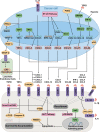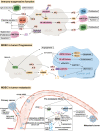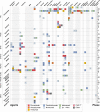Landscape of Myeloid-derived Suppressor Cell in Tumor Immunotherapy
- PMID: 34689842
- PMCID: PMC8543853
- DOI: 10.1186/s40364-021-00333-5
Landscape of Myeloid-derived Suppressor Cell in Tumor Immunotherapy
Erratum in
-
Correction to: Landscape of Myeloid-derived Suppressor Cell in Tumor Immunotherapy.Biomark Res. 2022 Feb 7;10(1):7. doi: 10.1186/s40364-022-00351-x. Biomark Res. 2022. PMID: 35130967 Free PMC article. No abstract available.
Abstract
Myeloid-derived suppressor cells (MDSC) are a group of immature cells that produced by emergency myelopoiesis. Emerging evidences have identified the vital role of MDSC in cancer microenvironment, in which MDSC exerts both immunological and non-immunological activities to assist the progression of cancer. Advances in pre-clinical research have provided us the understanding of MDSC in cancer context from the perspective of molecular mechanism. In clinical scenario, MDSC and its subsets have been discovered to exist in peripheral blood and tumor site of patients from various types of cancers. In this review, we highlight the clinical value of MDSC in predicting prognosis of cancer patients and the responses of immunotherapies, therefore to propose the MDSC-inhibiting strategy in the scenario of cancer immunotherapies. Phenotypes and biological functions of MDSC in cancer microenvironment are comprehensively summarized to provide potential targets of MDSC-inhibiting strategy from the aspect of molecular mechanisms.
Keywords: Immunotherapy; Myeloid-derived suppressor cells; Tumor.
© 2021. The Author(s).
Conflict of interest statement
The authors have no conflicts of interest to declare.
Figures






References
-
- Hanahan D, Coussens LM. Accessories to the crime: functions of cells recruited to the tumor microenvironment. Cancer Cell. 2012;21(3):309–322. - PubMed
Publication types
Grants and funding
LinkOut - more resources
Full Text Sources

